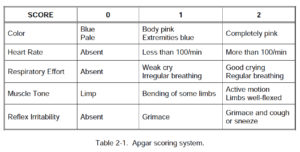a. Life-threatening problems the newborn may have are your first concern. Therefore, begin your assessment by checking the newborn’s airway, breathing, and circulation. Included in your initial assessment is the newborn’s ability to adapt to his new environment upon birth. The Apgar score is used to measure this adaptability.
b. The Apgar scoring system was devised by an American anesthesiologist to assess the physical condition of a newborn baby. This method assesses various aspects of the newborn’s health at one minute after birth and at five minutes after birth. Evaluated are the infant’s color (appearance), respiratory effort, muscle tone, reflex irritability (grimace in response to slap), and heart rate (pulse). Each feature is given a score of from 0 to 2. The numbers are added to give a total possible score of 10 (2 points in each of the 5 categories).
c. The Apgar score at the one-minute check and the five-minute check indicate how the newborn is doing in the first few minutes of life. A low score on the one-minute test will often improve on the five-minute test. This indicates that the problem was temporary and has been corrected. Look at tables 2-1 and 2-2 to see the scoring system and the meaning of the scores.


